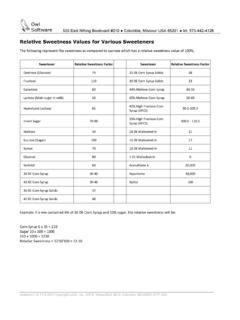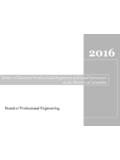Transcription of 3 Vorticity, Circulation and ... - Columbia University
1 3 vorticity , Circulation and Potential Definitions Vorticityis a measure of the local spin of a fluid element given by~ = ~v(1)So, if the flow is two dimensional the vorticity will be a vectorin the directionperpendicular to the flow. Divergenceis the divergence of the velocity field given byD= .~v(2) Circulationaround a loop is the integral of the tangential velocity around the loop = ~ ~l(3)For example, consider the isolated vortex patch in Fig. 1. The Circulation aroundthe closed curve C is given by = c~ ~l= ( ~v).d~s= ~ .d~s= Aads=aA(4)where we have made use of Stokes theorem. The Circulation around the loop canalso be approximated as the mean tangential velocity times the length of the loopand the length of the loop will be proportional to it s characteristic length the loop were a circleL= 2 r.
2 It therefore follows that the tangential veloctityaround the loop is proportional it does not decay exponentially withdistance from the vortex patch. So regions of vorticity have aremote influence onthe flow in analogy with electrostratics or gravitational fields. The Circulation isdefined to be positive for anti-clockwise integration around 1:An isolated vortex patch of vorticityapointing in the direction out of the pagewill induce a Circulation around the loop C with a tangentialvelocity that s proportional to theinverse of the characteristic length scale of the loop (r). vorticity and Circulation in a rotating reference frame Absolute vorticity (~ a) = vorticity as viewed in an inertial reference frame. Relative vorticity (~ ) = vorticity as viewed in the rotating reference frame of theEarth.
3 Planetary vorticity (~ p) = vorticity associated with the rotation of the Earth.~ a=~ +~ p(5)where~ a= ~vI,~ = ~vRand~ p= 2~ . Often we are concerned with horizontalmotion on the Earth s surface which we may consider using a tangent plane approximationor spherical coordinates. In such a situation the relative vorticity is a vector pointing inthe radial direction and the component of the planetary vorticity that is important is thecomponent pointing in the radial direction which can be shownto be equal tof= 2 sin .So, when examining horizontal motion on the Earth s surface we have~ a=~ +f(6)where the relative vorticity in cartesian or spherical coordinates in this situation is asfollows:~ =( v x u y) kor~ =(1a v 1acos (ucos ) ) r.
4 (7)The absolute Circulation is related to the relative Circulation by a= r+ 2 An(8)whereAnis the component of the area of the loop considered that is perpendicular to therotation axis of the ScalingsThe relative vorticity for horizontal flow scales asU/Lwhereas the planetary vorticityscales asf. Therefore another way of defining the Rossby number is by the ratio of therelative to planetary Conventions In the Northern HemisphereHigh pressure systems (anticyclones): <0, <0, Clockwise pressure systems (cyclones): >0, >0, Anti-clockwise flow. In the Southern HemisphereHigh pressure systems (anticyclones): >0, >0, Anticlockwise pressure systems (cyclones): <0, <0, Clockwise 2:Schematic illustrating the induction of a Circulation around a loop associated withthe planetary Kelvin s Circulation theoremIn the following section, Kelvin s Circulation theorem willbe derived.
5 This theorem pro-vides a constraint on the rate of change of Circulation . Consider the Circulation around aclosed loopC. Consider the loop to be made up of fluid elements such that the time rateof change of the Circulation around the loop is the material derivative of the circulationaround the loop given byD Dt=DDt C~ ~l= CD~ ~l+ C~ ~lDt(9)The second term can be re-written using the material derivative of line elements as follows C~ ~lDt= C~v.(d~l. ~v) = Cd~l. (12|~v|2) = 0(10)This term goes to zero as it is the integral around a closed curve of the gradientof a quantity around that curve. We can then make use of our momentum equation(neglecting viscosity and including friction) to obtain an expression for the rate of changeof the relative circulationD Dt= C( 2~ ~v).
6 D~l C p .d~l+ C~ ~l(11)where~Ffis the frictional force per unit mass. There are therefore three terms that canact to alter the Circulation , each of these will now be examined in more detail. The Coriolis term:Consider the Circulation around the curve C in a divergentflow as depicted Fig. 2. It is clear that the coriolis force acting on the flow field actsto induce a Circulation around the curve 3:An extremely baroclinic situation in pressure coordinates. Two fluids of differentdensities 1and 2are side by side ( 1< 2). The baroclinic term generates a Circulation whichcauses the denser fluid to slump under the lighter one until eventually an equilibrium is reachedwith the lighter fluid layered on top of the denser fluid and thebaroclinic term =0.
7 The baroclinic term C p .d~l: This term can be re-written in a more useful formusing stoke s theorem and a vector identity as follows C p .d~l= A ( p ).d~s= A( p) 2d~s(12)From this it can be seen that this term will be zero if the surfaces of constantpressure are also surfaces of constant density. A fluid isBarotropicif the densitydependsonlyon pressure = (p). This implies that temperature does notvary on a pressure surface. In a barotropic fluid temperature does not vary on apressure surface and therefore through thermal wind the geostrophic wind does notvary with height. In contrast a fluid isBaroclinicif the term p6= 0, forexample if temperature varies on a pressure surface then = (p, T) and the fluidis baroclinic. In a baroclinic fluid the geostrophic wind willvary with height andthere will be baroclinic generation of example, consider the extremely baroclinic situation depicted in Fig.
8 3. Weare considering here a situation with pressure decreasing with height and two fluidsside by side of different densities 1and 2with 1> 2. pis non-zeroand it can be seen that it would act to induce a positive Circulation . As a resultof this Circulation the denser fluid slumps under the lighter fluid until eventuallyequilibrium is reached with the lighter fluid layered on top of the denser baroclinic term can also be written in terms of temperature and potentialtemperature p ds= ( ln T)ds(13)Consider Fig 4 showing the zonal mean temperature and potential temperature inthe troposphere. In the tropics the temperature and potential temperature surfacesnearly coincide. In contrast in the mid-latitudes it is clearthat the temperatureand potential temperature surfaces do not coincide, or similarly there is a horizontaltemperature gradient on pressure surfaces.
9 Therefore, in the midlatitudes there isa large amount of baroclinic generation of Circulation and vorticity responsible forthe cyclonic systems always present at such (hPa)T annual mean200210210220220220220220230230230230 2402402402402502502502502602602602602702 7028029020021021022022022022022023023023 0230240240240240250250250250260260260260 270270280290-50050 Latitude10008006004002000 Pressure (hPa)Theta annual mean260270270280280290290300300310310320 3203303303403403503503603603703703803803 9039040040026027027028028029029030030031 0310320320330330340340350350360360370370 380380390390400400 Figure 4:Annual mean era-40 climatology of (top) Temperature and (bottom) Potential tem-perature. The friction term- Consider friction to be a linear drag on the velocity with sometimescale ~Ff= ~v.
10 This givesD Dt= C~ 1 C~ ~l= (14) friction acts to spin-down the 11 provides us withKelvin s Circulation theoremwhich states thatifthe fluid is barotropic on the material curve C and the frictional force on C is zero thenabsolute Circulation is conserved following the motion of the fluid. Absolute circulationbeing given by a= + 2 An(15)In other words there will be a trade off between the relative and planetary Fig. 5. This shows a material curve that is shifted to higher latitude. Asthe curve moves to higher latitude the area normal to the Earth s rotation axis willincrease and so the Circulation associated with the planetary vorticity increases (2 An).In order to conserve the absolute Circulation the relative Circulation must decrease (ananti-cyclonic Circulation is induced).













